A few weeks ago, Rafael Mizrahi told me about the 4th Kinnernet, a hyper-geek event organized each year on the southern shores of the Sea of Galilee (Kinneret Lake) in northern Israel. I checked out the website and started bombarding Rafael with questions “What’s this robots?” “And that vehicle?” “How about this gaming arcade?” Here’s a few notes from our conversation:
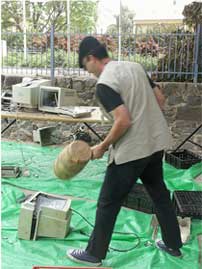
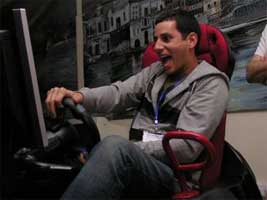 Computer Crash Course and Game Rider
Computer Crash Course and Game Rider
Set up in cooperation with Hubert Burda Media, creators of DLD conference, and following Tim O’Reilly’s Foo Camp, KinnerNet intvited about 150 technology addicts and creative people to gather informally and discuss topics and concepts such as software development, internet culture, social networks, web services, Wi-Fi, open source, cellular services, computer games, interactive TV, VOIP, technological trends, gadgets, security, etc. The general purpose is to share thoughts, work-in-progress, show off the latest tech toys and hardware hacks, and tackle challenging problems. The camp is a closed and private event and participating to it means contributing.
Rafael defines himself as an “artificial vision explorer” at Feng-GUI lab (which developed the ViewFinder, an algorithm that simulates the human eyes and brain and what would be the gaze path of the eye movements while being exposed to visuals. Similar algorithms are embedded into robots) and a member of GarageGeeks (which looks like “crazy projects paradise”.)
As part of the Robot Extravaganza of KinnerNet 2007 camp, he presented the GuitarHeroNoid which he built together with Tal Chalozin. The full-scale humanoid autonomously plays the Sony PlayStation game Guitar Hero II (video of GuitarHeroNoid playing the song Woman by Wolfmother).
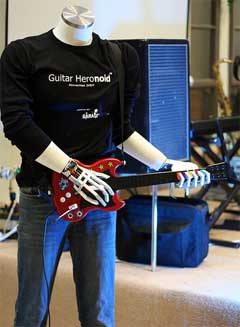 Can you tell us more about the robot that plays the PlayStation game “Guitar Hero”? How does it work and play?
Can you tell us more about the robot that plays the PlayStation game “Guitar Hero”? How does it work and play?
At the game, each song is presented on a set of five columns, resembling a real guitar fret board, that scroll constantly towards the player. The five columns correspond to the five fret buttons and appropriately colored notes appear in these columns.
We connected the PlayStation video output using a capture device into a computer and by live video streaming filter capture the video frames as images. Each image is being processed and the detected notes are sent through the parallel output or through network cable directly into the robot. This distributed architecture is also used by a robotics bio-technology called Remote Surgery :) and actually this distribution saved us when my parallel output was burned by an electric shock coming back from the robot solenoids, and we separated the process into two laptops.
Tal built computer-controlled, solenoids fingers that matched the fret board and strings in the game. Getting the fingers to press the fret buttons and hit the strum correctly was the hard part.
Tal took a storeroom mannequin and positioned the arms to hold the guitar. But the arms couldn’t be put in the right position, so he had to break and glue them to hold the guitar right. All the robot wiring is inside the mannequin ending at a control panel on the back of its neck.
This first public demonstration of GuitarHeroNoid received a rock star ovation from the ultra-geek audience. We also prepared a multiplayer mode, so you can play against the robot. Pushing the envelope higher, maybe next year we will build a robot that plays the game “dance dance revolution� (known as Dancing Stage in Europe).
Now how about “Real Pacman”?
The Real Pac Man (Tal Chalozin, Niv Efron) main idea was to build some old school tech symbol using as much nowadays-technologies as we can find. Right away we knew that we want a large scale game that will give the feeling of the “PacMan come to life…”
The game board made of a projector mounted on a stand, projecting a 15-square-meters game board on the floor. The PacMan was a wireless Pac-look-a-like robot which “drives” over a game board, equipped by RFID reader, Bluetooth transceiver controlled by ATMEL microcontroller, riding on a game board marked with RFID tags.
At the button of the PacMan there is an RFID reader that reads the tag location and sends it back to the game “engine”. The game engine is a java game we hacked, running on a laptop computer.
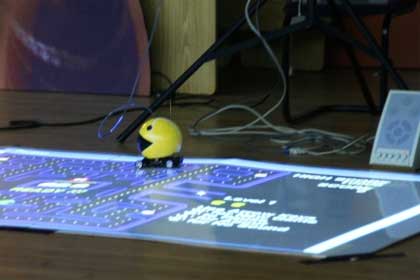
The result is that you are playing with a completely realistic PacMan over a full virtual game board, but they communicate as if they are one.
To make it more useless tech powered, we’ve written a J2ME application running on a cellular phone for controlling the PacMan. So, instead of playing with the laptop keyboard, you play the game on your cell, which sends via Bluetooth the control commands.
The next step is to make it a multiplayer, PacMan and ghosts…
Pac Man does not get anymore realistic than that!
All around the room were screens and gaming consoles and a hydraulic driving simulator, so you could just sit down and rumble. At the center of the gaming room there were two home made arcade tables, one crafted by Davidi Silberstein and the other by Amit Jurgenson, both musicians, handy-men and old-school gamers.
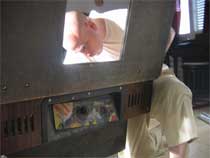
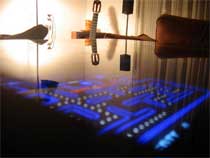 Arcade Machine Quest and Amit’s Arcade Machine
Arcade Machine Quest and Amit’s Arcade Machine
And the hydraulic driving simulator?
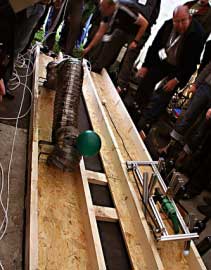 Power tool drag racing took place inside a large and crowded tent. Crossing the middle of the tent, were two long wooden strip tracks in which the racers ran, dragging their electricity cables behind them. The race judges where Michael Shiloh, co-founder of MakingThings and an annual participant of drag racing, World class notorious hacker Pablos Holman who breaks and builds new technologies and Eyal Gever with the “from a designer perspective” opinion.
Power tool drag racing took place inside a large and crowded tent. Crossing the middle of the tent, were two long wooden strip tracks in which the racers ran, dragging their electricity cables behind them. The race judges where Michael Shiloh, co-founder of MakingThings and an annual participant of drag racing, World class notorious hacker Pablos Holman who breaks and builds new technologies and Eyal Gever with the “from a designer perspective” opinion.
Image on the right: Vladimir’s Warm vs. Shy Vardi’s Spider (photo: Yaniv Golan)
Of course, the fastest racers were the ones Michael and Pablos brought. Michael had Jim Mason‘s blazing fast “monorail” that runs as a monorail train on top of one of the sides of the track, and Pablos had borrowed an “Old Killdoggie” model racer, which is a modified grinder with inline-skate wheels. But getting first to the end of the track is not the goal of such a race.
At least half of the races were built by Yedidya (Didi) Vardi and his crew. Didi, a junk collector, designer of hands-on science models and screws-and-bolts seller. On Didi’s team were Shy Vardi, Vladimir Zviagintsev an aircraft engineer, who built the kites that were raised to thousands of feet in height, and Shlomo Abayoff.
Babylon Tower Racer was built by the GarageGeeks Zvika Netter, Yuval Tal, Ohad Pressman, Gil Hirsch and Tal Chalozin. A laptop sitting on a wagon with electric lawnmower wheels, motivated to move forward by SMS sent by the audience to Yuval’s phone number. Each time an SMS arrived, the light blob was blinked the message in morse code, and a Text-to-Speech algorithm announced the message using the racer’s speakers.
More racers such as the bottle Xylophone, playing on bottles set at the sides of the track, containing various amount of water for different tones. A CleanTech racer that needed no electricity but the moments of falling parts, Vacuuming Hovercraft, Skateboard Ventilator, and Parking, which actually did park most of the time and didn’t finish the race.
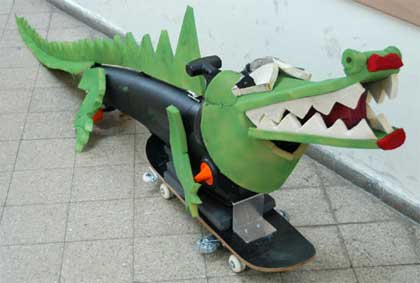 Crocodile “rocket” Handy by Naama, Achi and Yariv
Crocodile “rocket” Handy by Naama, Achi and Yariv
KinnerNet looks like a hell of fun. Why is the number of participants limited to 150?
Are there like-minded events in the country during the rest of the year?
KinnerNet is a a lot of fun and in order to participate, you have to contribute and not act as a “camp potato”. I guess that the number is limited because only super geeks are invited. Since there are many people who wish to share and expand their connections, forks of miscellaneous camps and events are being formed. For example, GeekCon, EureKamp, and even us, the GarageGeeks are hosting (images) content evenings, barbeques and Gaming Lan Parties (images.)
I saw on the programme that there was some place dedicated to digital art? What happened there? Any good work you’d like to highlight?
I think digital art was everywhere. In the evening we all gathered in the dining room and watched videos prepared by participants. Michal Levy, for example, a saxophonist and graphic designer, presented a beautiful visual interpretation that she made for John Coltrane’s Giant Steps.
We were asked to bring from home any junk we don’t need anymore and Hanoch Piven hosted a face making workshop that was one of the most popular happenings. Hanoch has been making collages with objects – mainly illustrations of faces for magazines and newspapers since 1992.
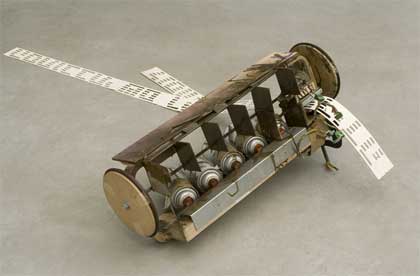 The GraffitiPrinter
The GraffitiPrinter
Ariel Schlesinger, presented his GraffitiPrinter, a handheld printer, feed from punch card that translates to spray writing on the wall.
Inside a large room, Ezri Tarazi along with the creative industrial designers Maayan Hagar and Yasmin Yotam, and anyone who wished to help, built a chain reaction sculpture called a machine that does something that does something.
Next to that sculpture, and the Superman Simulator, Didi Vardi presented his Vibrating Laser Balls Organ, a 400 pound golf-ball-and-aluminum Stradivarius, a wonderful, real musical instrument inspired by the Animusic’s virtual Pipe Dream. (video)
I’m also very curious about the Cooking Madness event. Was there anything edible there? What does “Cotton Candy with ambient touch” taste like for example?
 Cooking Madness was more than edible all right. As you cannot be in all of the activities, I didn’t get the chance to taste that Fluffy Clouds Cotton Candy. But I ate two pieces from Tal’s mother’s terrific passion fruit cheese cake, which was introduced by 3 Powerpoint slides at the camp’s first gathering. Most of the time I stood next to Yuval Tal who prepared the Extra alcoholic chocolate drink, and verified the quality of the cocktail.
Cooking Madness was more than edible all right. As you cannot be in all of the activities, I didn’t get the chance to taste that Fluffy Clouds Cotton Candy. But I ate two pieces from Tal’s mother’s terrific passion fruit cheese cake, which was introduced by 3 Powerpoint slides at the camp’s first gathering. Most of the time I stood next to Yuval Tal who prepared the Extra alcoholic chocolate drink, and verified the quality of the cocktail.
At night, things were getting weirder, people juggling, geeks playing arcades or fighting each other with light sabres, and Vladimir, inspired by The Burning Man Project, was riding a bicycle while dragging another bicycle with a burning doll, which was created earlier by Didi’s team.
I’d like to finish by send a enormous thanks and hugs to anyone who helped in the great 2007 KinnerNet event and also thank Yaniv Golan and Alex Sirota for the photos.
Thanks Rafael!
A last tip from Rafael: Gil Rimon and Lior Katz’s Supermarket 2.0 parody (video.)
More images at Flickr tag KinnerNet2007. Photo of GuitarHeroNoid by Yaniv Golan. More images.
